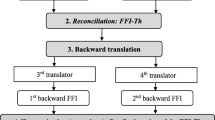Abstract
Background
Despite its wide use in clinical outcome measurement, there is yet no validated German language version of the AOFAS-AHS available. After finishing cross-cultural adaption of the AOFAS-AHS according to the AAOS guidelines, an analysis of agreement was carried out.
Methods
This was done by means of the 18-item Foot Function Index in its validated German translation by Naal et al. (FFI-D). The results of 91 orthopedic patients as well as healthy persons in both scores were then compared intraindividually. The cohort consisted of 46 individuals with hindfoot disorders and 45 persons without any hindfoot complaints. The FFI-D-Score was linearly transformed in the range 0–100 points of the AOFAS.
Results
Encouraging correlation was then found for the patients with hindfoot disorders (Spearman’s correlation 0.73 (95 % CI 0.52–0.85); a median deviation of −2 points (interquartile range −13 points; +13 points) in patients with hindfoot disorders implied good median intraindividual score concordance. However, with 30 of these 46 patients showing score deviations beyond or below a pre-specified ±10 points range of clinically tolerable deviations, the scores cannot be considered exchangeable.
Conclusion
Although the agreement analysis was performed for the German translation of the two questionnaires, analogous results can be expected also for other languages. It should be noted that the results do not allow for judging which of the scores is better suited to give a valid statement on patient outcome in treatment of hindfoot disorders. To verify which of these two scores is better suited to represent hindfoot-dysfunction a subsequent study using instrumental gait analysis and surface EMG is being carried out.




Similar content being viewed by others
References
Guyton GP (2001) Theoretical limitations of the AOFAS Scoring Systems: an analysis using Monte Carlo modelling. Foot Ankle Int 22:779–787
SooHoo NF, Shuler M, Fleming LL (2003) Evaluation of the Validity on the AOFAS clinical rating system by correlation to the SF-36. Foot Ankle Int 24:50–55
Madeley NJ, Wing KJ, Toplis C, Penner MJ, Glazebrook MA, Younger ASE (2012) Responsiveness and validity of the SF-36 Ankle osteoarthritis Scale, AOFAS ankle hindfoot scale, and Foot Function Index in end stage ankle arthritis. Foot Ankle Int 33:57–63. doi:10.3113/FAI.2012.0057
Button G, Pinney S (2004) A meta-analysis of outcome rating scales in foot and ankle surgery: is there a valid, reliable, and responsive system? Foot Ankle Int 25:521–525
Ibrahim T, Beiri A, Azzabi M, Best AJ, Taylor GJ, Menon DK (2007) Reliability and validity of the subjective component of the American orthopaedic ankle society clinic rating scales. J Foot Ankle Surg 46:65–74
Kitaoka HB, Alexander IJ, Adellar RS, Numley JA, Meyerson MS, Sanders M (1994) Clinical rating systems for the ankle-hindfoot, midfoot, Hallux and lesser toes. Foot Ankle Int 15:349–353
Kostuj T, Schaper K, Baums MH, Lieske S (2014) German Validation of the AOFAS ankle Hindfoot Scale Fuspru. Fuß Sprunggelenk 12:100–106. doi:10.1016/j.fuspru.2014.02.002
Beaton DE, Bombardier C, Guillemin F, Ferraz MB (2000) Guidelines for the process of cross-cultural adaption of self-report measures. Spine 25:3186–3191
Naal FD, Impellizzeri FM, Huber M, Rippstein PF (2008) Cross-Cultural Adaption and Validation of the Foot Function Index for use in German-speaking patients with foot complaints. Foot Ankle Int 29:1222–1228. doi:10.3113/FAI.2008.1222
Budiman-Mak E, Conrad KJ, Roach KE (1991) The Foot Function Index: a measure of foot pain and disability. J Clin Epidemiol 44:561–570
Budiman-Mak E, Conrad K, Stuck R, Matters M (2006) Theoretical model and Rash analysis to develop a revised foot function index. Foot Ankle Int 27:519–527
Bland JM, Altman D (1986) Statistical methods for assessing agreement between two methods of clinical measurement. Lancet 1:307–310
Bühl A (2012) In SPSS 20. Einführung in die moderne Datenanalyse, 13th 205 edn, Pearson Deutschland GmbH, Dortmund, Germany, p 420
Baumhauer JF, Nawoczenski DA, DiGiovanni BF, Wilding GE (2006) Reliability and validity of the American Orthopaedic Foot and Ankle Society Clinical Rating Scale: a pilot study for the hallux and lesser toes. Foot Ankle 211 Int 27:1014–1019
Kuyvenhoven MM, Gorter KJ, Zuithoff P, Budiman-Mak E, Conrad KJ, Post MWM (2002) The foot function index with verbal rating scales (FFI-5pt): A clinimetric evaluation and comparison with the original FFI. J Rheumatol 29:1023–1028
Paez-Monguer J, Budiman-Mak E, Cuestas-Vargas AI (2014) Cross-cultural adaption and validation of the Foot Function Index to Spanish. Foot and Ankle Surgery 20:34–39. doi:10.1016/j.fas.2013.09.005
Acknowledgments
This study was granted by the German Foot and Ankle Society (DAF).
Conflict of interest
Parts of the results presented in this manuscript may be included in a poster-presentation at the 2014 annual meeting of the German Society for Medical Informatics, Biometry and Epidemiology (GMDS e.V.) in September.
Author information
Authors and Affiliations
Corresponding author
Rights and permissions
About this article
Cite this article
Kostuj, T., Krummenauer, F., Schaper, K. et al. Analysis of agreement between the German translation of the American Foot and Ankle Society’s Ankle and Hindfoot Scale (AOFAS-AHS) and the Foot Function Index in its validated German translation by Naal et al. (FFI-D). Arch Orthop Trauma Surg 134, 1205–1210 (2014). https://doi.org/10.1007/s00402-014-2046-0
Received:
Published:
Issue Date:
DOI: https://doi.org/10.1007/s00402-014-2046-0




